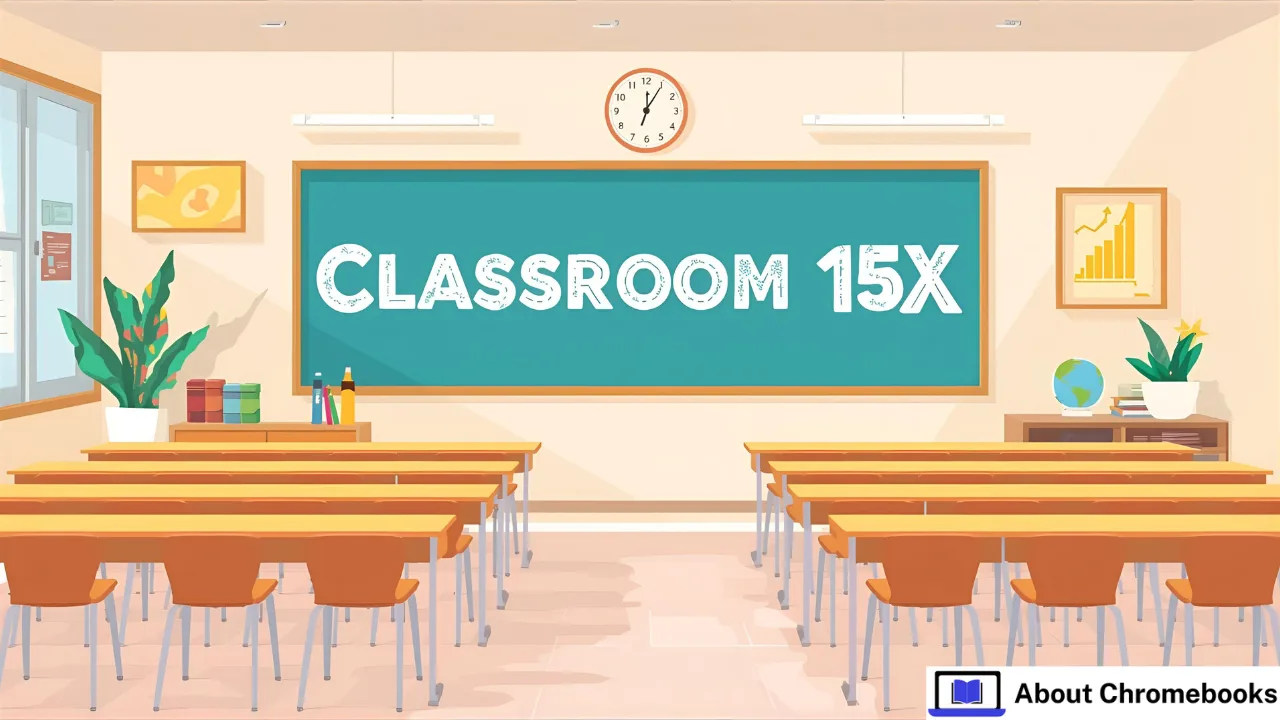Classroom 15x is gaining attention among teachers and school leaders as a flexible, tech-smart learning model that blends smaller class groups, personalized learning, and adaptable space design. Instead of focusing only on technology or large-scale infrastructure, Classroom 15x emphasizes three key ideas: small groups of around fifteen students, movable furniture that supports collaboration, and low-friction digital tools that simplify instruction rather than complicate it.
Educators testing this model report higher student engagement, smoother classroom management, and more time for feedback and creativity. The “15x” concept doesn’t demand a total redesign; it can start with simple changes such as breaking one big class into two pods, rearranging desks, or introducing quick-access tech tools.
This article explains what Classroom 15x really means, how it differs from common misconceptions, what evidence exists, and how you can apply it step-by-step in your own school.
What “Classroom 15x” Actually Means
The phrase “Classroom 15x” appears across many education discussions, product pages, and teaching communities, but it generally refers to a set of practices rather than a single product. Broadly, there are three common interpretations:
-
The Pedagogical Model – a student-centered design using smaller pods of fifteen learners where teachers can coach rather than lecture.
-
The Spatial Concept – classrooms equipped with flexible furniture, open zones, and multipurpose layouts that allow for collaboration, independent work, and quick transitions.
-
The Technological Layer – the use of simple, integrated digital tools (learning apps, dashboards, or screen-sharing systems) that support personalized instruction.
Some websites also use “Classroom 15x” as a name for online student portals or game hubs, but in education planning, the term mostly refers to this small-group, flexible-design model.
Why Class Size and Flexibility Matter
Educational research has long shown that smaller groups improve participation, reduce behavioral issues, and give teachers better insight into each student’s progress. A 15-student pod allows for personalized attention without overburdening the teacher. Flexibility in furniture and layout gives students control over where and how they learn—standing desks for active learners, quiet corners for reading, group tables for collaboration.
The “x” in Classroom 15x is often interpreted as a multiplier for innovation—suggesting that small, well-structured environments can multiply learning outcomes when combined with smart use of technology and human interaction.
Core Components of Classroom 15x
1. Pod Size of About 15 Students
Fifteen students per group strike a balance between individual attention and group energy. Teachers can track each learner’s growth while fostering peer support and collaborative learning.
2. Flexible Space Design
Replace static rows with moveable desks and modular furniture. Zones can include:
-
Collaboration areas for small-group work.
-
Quiet zones for focus or reading.
-
Presentation corners for mini-lessons or student showcases.
-
Tech bars with shared devices or charging stations.
3. Low-Friction Technology
Technology should make teaching easier, not harder. Use browser-based learning apps, simple analytics dashboards, and one-click screen sharing. Avoid heavy systems that demand constant troubleshooting.
4. Teacher Coaching and Support
Professional learning is crucial. Teachers need guided practice, not just new equipment. Peer coaching, co-teaching, and reflective observation cycles help maintain consistency and confidence.
5. Quick Assessment Loops
Frequent, low-stakes assessments—such as short quizzes, exit tickets, or digital polls—give teachers immediate insight into what students know and what needs reinforcement.
Step-by-Step Implementation Plan
Phase 1: Explore and Prepare (2–4 Weeks)
-
Observe your current classrooms: Where are the bottlenecks? Which activities stall student focus?
-
Interview teachers and students about challenges and needs.
-
Identify one classroom or subject to pilot the 15x approach.
Phase 2: Pilot a Single 15x Classroom (6–10 Weeks)
-
Divide one class into smaller pods of about fifteen students.
-
Introduce flexible seating or rearranged furniture.
-
Use one or two low-friction digital tools—perhaps a formative assessment app and a digital whiteboard.
-
Schedule weekly reflection meetings with the teacher to adjust routines.
Phase 3: Review and Refine
Collect both quantitative and qualitative data:
-
Engagement levels (time-on-task, participation).
-
Teacher workload and satisfaction.
-
Student feedback.
Analyze what worked and what needs improvement before scaling further.
Phase 4: Scale Gradually
Expand to multiple classrooms or departments. Continue coaching, maintain a simple tech ecosystem, and gather evidence on outcomes.
Phase 5: Sustain and Institutionalize
Embed Classroom 15x practices into professional learning communities and budgets. Keep a feedback loop active between administration, teachers, and students.
Budget Planning for Classroom 15x
1. Furniture and Layout:
Lightweight, modular desks or chairs can be purchased second-hand or repurposed. Estimate $1,000–$5,000 per classroom, depending on scale.
2. Technology:
Focus on affordable, browser-based apps with multi-device compatibility. Plan for $200–$2,000 annually per classroom depending on licenses.
3. Coaching and Training:
Invest around $1,000–$4,000 per teacher annually for sustained professional learning or mentorship.
4. Infrastructure:
Ensure stable Wi-Fi and sufficient charging points. Start with a small network upgrade if necessary.
By piloting first, schools can identify cost drivers and optimize resources before scaling across grades.
Practical Classroom Example
Objective: Reinforce understanding of a math concept (fractions or ratios).
Duration: 30 minutes
Structure:
-
Warm-Up (5 min) – Quick interactive poll or quiz to gauge prior knowledge.
-
Mini-Lesson (7 min) – Teacher models a real-world problem using a projector or tablet.
-
Pod Activity (12 min) – Each 15x group solves a slightly different problem; peers compare approaches.
-
Feedback Loop (6 min) – Students submit quick responses via digital form; teacher reviews top errors instantly.
This small-loop structure is easy to replicate across subjects and helps both students and teachers see measurable growth.
Benefits of Classroom 15x
1. Improved Engagement
Students participate more when they feel seen and heard. The 15-student format ensures every learner contributes during discussions.
2. Personalized Learning
Smaller groups enable differentiated instruction. Teachers can assign adaptive online exercises suited to each learner’s level.
3. Efficient Classroom Management
Fewer students per group mean fewer distractions, smoother transitions, and faster behavioral redirection.
4. Teacher Collaboration
With smaller groups, teachers can share best practices, observe one another, and co-teach more effectively.
5. Data-Driven Decisions
Integrated tech tools provide real-time analytics for attendance, participation, and mastery levels, allowing immediate instructional adjustments.
Challenges and How to Overcome Them
1. Misconceptions about Technology
Many assume Classroom 15x is all about gadgets. It’s not—it’s about pedagogy first, supported by practical technology.
2. Budget Constraints
Start small. Repurpose furniture and use free or open-source tools before investing in premium systems.
3. Teacher Resistance
Change can be intimidating. Offer coaching, celebrate small wins, and share real classroom success stories.
4. Infrastructure Gaps
A weak internet connection can disrupt learning. Consider offline-capable apps or local servers if broadband is limited.
5. Sustainability
Avoid initiative fatigue. Make Classroom 15x part of a long-term vision, not a one-year experiment.
Best Practices for Success
-
Begin with a Pilot: Test the approach in one or two classrooms first.
-
Document Everything: Take photos, record data, and collect reflections. Evidence strengthens credibility and future funding.
-
Engage Students: Ask for feedback on seating, layout, and digital tools.
-
Communicate with Parents: Share goals, safety policies, and expected learning benefits.
-
Review Monthly: Track engagement and academic indicators regularly.
SEO and E-E-A-T Strategy for Schools or Blogs
If you’re writing about Classroom 15x online, focus on building Experience, Expertise, Authoritativeness, and Trust (E-E-A-T).
-
Experience: Share first-hand classroom examples and outcomes.
-
Expertise: Include teachers’ credentials or quotes from educational coaches.
-
Authoritativeness: Reference pilot results, not just claims.
-
Trust: Be transparent about costs, time frames, and challenges.
Use relevant long-tail keywords such as:
-
“Classroom 15x model in education”
-
“15-student classroom benefits”
-
“Flexible learning space ideas”
-
“Technology integration for small groups”
Keep paragraphs short, use bullet points, and include subheadings—Google favors structured, scannable content.
Quick Start Checklist
-
Select one enthusiastic teacher for the pilot.
-
Choose fifteen students or one class section.
-
Rearrange the room into collaborative zones.
-
Select one low-friction tech tool for formative feedback.
-
Schedule three coaching sessions.
-
Collect engagement data weekly.
-
Reflect, refine, and plan expansion.
FAQs
1. What is Classroom 15x?
Classroom 15x is a small-group, flexible learning model that organizes about fifteen students per pod, integrates simple technology, and promotes personalized instruction.
2. Is Classroom 15x only about technology?
No. Technology is supportive, not central. The core of Classroom 15x is effective pedagogy—smaller classes, flexible spaces, and strong teacher-student relationships.
3. How much does it cost to implement Classroom 15x?
Costs vary by scale. A small pilot may need under $2,000 for rearrangement and coaching. Full implementation across multiple rooms can range higher depending on infrastructure and training.
4. What are the benefits of Classroom 15x?
Schools report improved student engagement, better focus, easier classroom management, and more personalized instruction.
5. Can small or low-income schools adopt Classroom 15x?
Yes. Start with one classroom, use low-cost or donated furniture, free digital tools, and focus on teacher training before equipment purchases.
Common Myths About Classroom 15x
Myth 1: It’s only for high-tech schools.
Reality: You can implement it with minimal tech—focus on layout and pedagogy first.
Myth 2: You need to rebuild classrooms.
Reality: Reorganization often achieves most benefits without construction costs.
Myth 3: Teachers must be tech experts.
Reality: The goal is to simplify, not complicate. One or two easy tools are enough to start.
Myth 4: It’s a trend that will fade.
Reality: The principles—personalization, flexibility, small groups—are grounded in decades of educational research.
Impact Measurement Tips
To evaluate your Classroom 15x pilot:
-
Track engagement: Observe active participation rates during lessons.
-
Monitor academic growth: Compare assessment results before and after the pilot.
-
Collect feedback: Survey students and teachers about satisfaction and perceived effectiveness.
-
Analyze behavior data: Look for declines in disciplinary incidents or off-task time.
-
Share outcomes: Publish short summaries for parents and stakeholders to maintain transparency and momentum.
Long-Term Vision
Once initial results are positive, expand Classroom 15x into a whole-school strategy. Build collaborative teacher teams, rotate subject specialists, and maintain continuous professional development. Integrate project-based learning and interdisciplinary modules that benefit from small groups and flexible spaces.
Over time, your school can create an adaptable learning culture that values autonomy, experimentation, and evidence-based improvement—core ideas behind Classroom 15x.
PedrovazPaulo Business Consultant for Scalable Growth
Conclusion
Classroom 15x isn’t just a buzzword—it’s a practical framework for modern teaching. By combining small-group learning, flexible classroom layouts, and accessible technology, educators can create more personalized, engaging, and efficient learning environments. It’s scalable, budget-friendly, and adaptable to diverse contexts.
Starting small—just one teacher, one room, and fifteen students—can spark lasting transformation. Success comes not from expensive hardware but from thoughtful design, supportive coaching, and consistent reflection. As more schools experiment with this model, evidence continues to grow that flexible, student-centered classrooms lead to stronger engagement and better outcomes.
If your goal is to make learning more human, more responsive, and more effective, Classroom 15x offers a clear, tested path forward. Begin with curiosity, measure progress, and share your results—the future classroom may be closer than you think.










